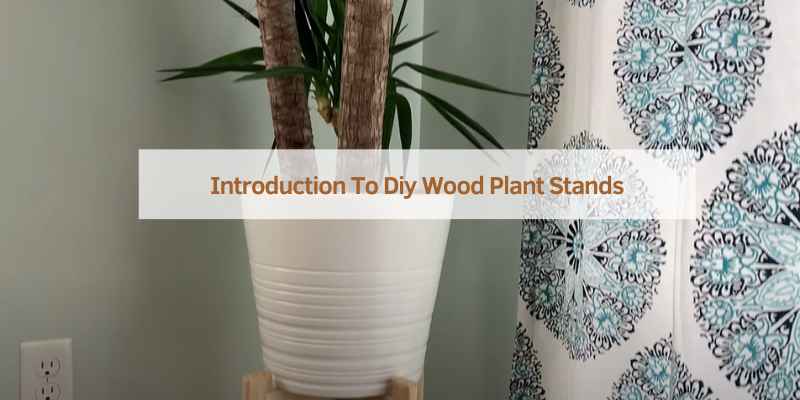Looking to create a DIY wood plant stand? You can easily make one with a few simple materials.
A wood plant stand is a great way to display your plants while adding a touch of natural beauty to your home. Whether you’re a seasoned woodworker or just starting out, crafting your own plant stand can be a rewarding and practical project.
In this guide, we’ll explore the steps and materials needed to create a stylish and functional wood plant stand that will complement your indoor or outdoor space. So, let’s get started on this fun and creative DIY project!
Introduction To DIY Wood Plant Stands
Build your own DIY wood plant stand to showcase your favorite greenery with a touch of personal style. This simple and rewarding project requires just a few tools and supplies and can be customized to fit any space or decor.
DIY wood plant stands are a fantastic way to add a touch of nature to your home while showcasing your greenery in style. These stands not only elevate your plants but also bring a rustic charm and natural warmth to any space. In this blog post, we will explore the benefits of elevating your greenery and why wood is an excellent choice for crafting these plant stands.
Benefits Of Elevating Your Greenery
- Enhanced visual appeal: Placing your plants on elevated stands adds height and dimension to your indoor or outdoor space, creating an eye-catching display.
- Improved air circulation: Elevating your plants allows for better airflow, preventing moisture buildup and reducing the risk of diseases.
- Optimal sunlight exposure: By raising your plants, you can ensure they receive adequate sunlight from all angles, promoting healthy growth.
- Protection from pests and pets: Keeping your plants off the ground helps protect them from curious pets and crawling insects that may cause damage.
- Organized and clutter-free space: A well-arranged collection of plants on stands creates an organized and visually appealing atmosphere, reducing clutter.
Why Choose Wood?
Wood is a popular choice for DIY plant stands due to its natural beauty, durability, and versatility. Here are a few reasons why wood stands out as the preferred material:
- Natural aesthetics: Wood brings a warm and earthy feel to any setting, effortlessly blending with various interior design styles.
- Strength and durability: Wooden plant stands are sturdy and can withstand the weight of potted plants, ensuring long-lasting support.
- Customization options: Wood can be easily cut, shaped, and painted to match your personal style and preferences, allowing for endless design possibilities.
- Sustainability: Opting for sustainably sourced wood or repurposing reclaimed wood promotes eco-friendly practices and reduces environmental impact.

Selecting The Right Wood
When it comes to crafting a DIY wood plant stand, selecting the right wood is crucial for both durability and aesthetics. The type of wood you choose will impact the overall look and longevity of your plant stand. Consider the following factors to make an informed decision.
Types Of Wood For Durability And Aesthetics
Choosing the right type of wood is essential for ensuring the durability and visual appeal of your plant stand. Different woods offer varying levels of strength and visual characteristics that can complement your indoor or outdoor space.
Eco-friendly Options
For those who prioritize sustainability, opting for eco-friendly wood options is a responsible choice. Certain wood species are known for their sustainable and environmentally friendly properties, making them ideal for eco-conscious DIY enthusiasts.
Tools And Materials Needed
When embarking on a DIY wood plant stand project, it’s essential to gather the right tools and materials. Here is a breakdown of what you’ll need:
Basic Woodworking Tools
- Saw
- Drill
- Screwdriver
Safety Gear
- Safety goggles
- Gloves
- Dust mask
Additional Supplies
- Wood glue
- Sandpaper
- Measuring tape
Design Ideas For Your Plant Stand
When it comes to designing a plant stand, there are various creative ideas that can enhance the aesthetic appeal of your indoor or outdoor space. Whether you prefer a simple and minimalist look or want to incorporate different shapes and textures, there are design options to suit every style and preference. Let’s explore some design ideas for your plant stand that will elevate the look of your greenery.
Simple And Minimalist
If you prefer a clean and understated look, a simple and minimalist plant stand design can complement any space. Opt for sleek, straight lines and a neutral color palette to create a modern and uncluttered appearance. Utilize materials like metal or wood for a timeless, minimalist aesthetic.
Tiered Designs For More Greenery
Maximize your greenery with tiered plant stand designs. By incorporating multiple levels, you can create a visually dynamic display for your plants. Consider a cascading effect with each tier holding different plant varieties, adding depth and dimension to your indoor or outdoor space.
Incorporating Shapes And Textures
Experiment with different shapes and textures to add visual interest to your plant stand. Mix and match geometric shapes or incorporate natural textures like rattan or wicker for a bohemian-inspired look. This can bring a unique and personalized touch to your plant display, creating a focal point in any room.
Step-by-step Guide To Building Your Plant Stand
Building your own DIY wood plant stand can be a rewarding and satisfying project. Not only will it add a touch of natural beauty to your home, but it will also showcase your creativity and craftsmanship. In this step-by-step guide, we will walk you through the process of creating your very own plant stand from scratch. So, let’s get started!
Cutting The Wood
The first step in building your plant stand is to cut the wood to the desired dimensions. Here’s a breakdown of the wood pieces you’ll need:
| Wood Piece | Dimensions |
|---|---|
| Legs | 2″ x 2″ x 30″ |
| Top Shelf | 1″ x 12″ x 12″ |
| Bottom Shelf | 1″ x 12″ x 14″ |
Ensure you measure and mark the dimensions accurately before cutting the wood. Safety is paramount, so remember to wear protective goggles and gloves while operating any cutting tools.
Assembling The Frame
Once you have all the wood pieces cut, it’s time to assemble the frame of your plant stand. Follow these steps:
- Start by attaching the legs to the top shelf. Align the legs with the corners of the top shelf and secure them using wood screws.
- Next, attach the bottom shelf to the legs. Make sure it is level and secure it with wood screws as well.
- Double-check that all the pieces are securely fastened and the frame is stable.
By now, your plant stand should start taking shape, and you can admire your progress!
Finishing Touches
Now that the frame is complete, it’s time to add some finishing touches to enhance its appearance and durability:
- Sand the entire surface of the wood to smoothen any rough edges or imperfections.
- Apply a coat of wood stain or paint of your choice to protect the wood and give it a beautiful finish.
- Allow the stain or paint to dry completely before placing your plants on the stand.
Voila! Your DIY wood plant stand is now ready to showcase your favorite plants in style.
Remember, building your own plant stand allows you to customize it to your exact preferences. Feel free to experiment with different wood types, colors, and designs to create a unique piece that reflects your personal taste.
Customizing Your Plant Stand
One of the best things about making your own DIY wood plant stand is the ability to customize it to your liking. By adding a personal touch to your plant stand, you can make it unique and match your home decor. Here are some ways to customize your plant stand:
Staining And Painting
Staining or painting your plant stand is an excellent way to add color and protect the wood from damage. Before staining or painting, make sure to sand the wood and remove any dust or debris. Then, use a foam brush to apply the stain or paint, and let it dry completely before adding a second coat if needed. You can choose a color that complements your home decor or go for a bold statement with a bright color.
Adding Personal Touches
You can add personal touches to your plant stand by incorporating your own style or adding decorative elements. For instance, you can add a small chalkboard to write the plant’s name or a quote. You can also use stencils to create unique designs on the wood or attach a decorative knob or handle to the top of the stand. Be creative and let your imagination run wild.
By customizing your DIY wood plant stand, you can create a unique piece that reflects your style and personality. Whether you stain, paint, or add personal touches, your plant stand will be a beautiful addition to your home decor.
Care And Maintenance
Proper care and maintenance are essential to keep your DIY wood plant stand looking its best over time.
Regular Cleaning Tips
- Remove dust with a soft cloth or feather duster.
- Use a mild wood cleaner for tougher stains.
- Ensure the stand is completely dry after cleaning.
Protecting The Wood
Applying a wood sealant every 6-12 months helps prevent moisture damage.
Avoid placing the stand in direct sunlight to prevent fading.
Use felt pads under pots to prevent scratches on the wood surface.
Showcasing Your Greenery
Enhance the beauty of your space with a DIY wood plant stand that elegantly displays your favorite greenery. Whether you have vibrant flowers, lush ferns, or stylish succulents, a plant stand can elevate your plants to new heights.
Arranging Plants For Visual Impact
Arrange plants by height, color, and texture for a visually stunning display. Tall plants at the back, medium in the middle, and low plants at the front create depth and interest.
Tips For Plant Care
- Ensure plants receive adequate sunlight.
- Water plants according to their specific needs.
- Prune regularly to maintain plant health.
- Rotate plants for even growth.

Frequently Asked Questions
How To Build A DIY Wood Plant Stand?
To build a DIY wood plant stand, gather materials, measure, cut wood, assemble pieces, and finish with paint or stain. Follow step-by-step instructions for a sturdy and stylish plant stand.
What Are The Benefits Of Using A Wood Plant Stand?
Wood plant stands offer durability, natural aesthetic, customization options, and stability for indoor plants. Elevate plants for better visibility, air circulation, and to prevent damage to floors.
Which Wood Types Are Best For A Plant Stand?
Popular wood types for plant stands include oak, pine, cedar, and teak due to their strength, durability, and aesthetic appeal. Choose a wood that complements your decor and fits your plant’s weight and size requirements.
Conclusion
Creating a DIY wood plant stand is an easy and affordable way to add a touch of nature to your home decor. With just a few simple materials and some basic woodworking skills, you can design a unique plant stand that perfectly fits your style and space.
Plus, by building it yourself, you can ensure it’s made from sustainable materials and matches your exact specifications. So why not give it a try and see how you can elevate your indoor gardening game?


